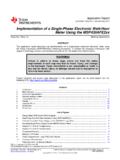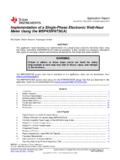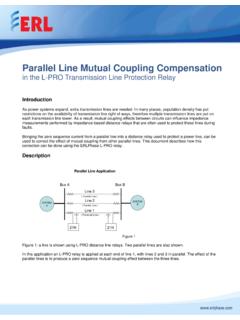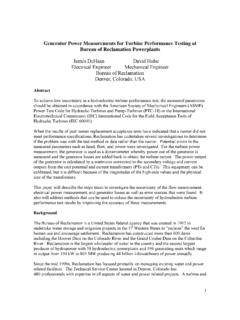Transcription of EDEXCEL NATIONAL CERTIFICATE/DIPLOMA UNIT …
1 (c) 1 EDEXCEL NATIONAL CERTIFICATE/DIPLOMA unit 67 - further electrical principles NQF LEVEL 3 OUTCOME 4 - 3 PHASE POWER unit content 4. Understand three-phase alternating current (AC) theory Three-phase AC theory: principles of single-phase and three-phase supplies rotation of a single coil in a magnetic field, rotation of three identical coils fixed 120 apart in a magnetic field; star and delta methods of connection for power distribution systems; three and four wire systems; voltage relationships for star and delta connections under balanced conditions of load; calculation of power in balanced and unbalanced three-phase loads P = 3 VLIL cos , P = 3Ip2 Rp Power measurements in a three-phase AC system: delta system one wattmeter method, star system - two wattmeter method Three-phase AC induction motor: construction stator, rotor, poles; principle of operation production of torque, synchronous speed, number of poles, starting methods, characteristics (speed/torque/efficiency versus current curves); concept of a rotating magnetic field application of a three-phase supply to the stator windings, flux generated by each phase of the stator winding It assumed that the student has studied the electrical and Electronic principles module.
2 (c) 2 SINGLE PHASE GENERATION - REVISION Consider a very simple generator consisting of a loop rotating in a uniform magnetic field. The generated in the conductor is obtained from the basic equation e = B v. In this equation v is the velocity of the conductor at right angles to the flux and clearly when the loop is horizontal in the diagram this is the velocity of the conductor. When the loop is in the vertical plane the velocity is parallel to the flux and no is produced. At any other position the velocity is found by resolving v in the vertical direction. v(vertical) = v sin Hence E = B v Sin and this gives a sinusoidal alternating voltage. In a practical generator the loop would have more turns to increase the effective length and slip rings would be used to connect the loop to the external system.
3 THREE PHASE GENERATION Suppose we use three loops A B and C instead of one spaced at 120o as shown. Each loop has two ends and if we want to measure the voltages relative to ground zero then we would have to connect one end of all three together and ground it. We have in affect three generators producing an with the peaks spaced 120o apart as shown. This is 3 phase This form of connection is called STAR. We would need three slip rings to connect the loops to the external system and another for the common connection. Notice that the voltage difference between any two lines can be greater at a given instance than the voltage relative to ground. The current owing in any loop is the same as the current flowing in the lines A, B and C.
4 It is possible to connect the loops in a triangular configuration so that the common wire is not needed. When connected as shown it is called a DELTA formation. In this case, we have no ground. The current flowing in any loop is not the same as the current flowing in the lines A, B and C. We can still use a ground zero to measure the voltages relative to ground. (c) 3 We will not discuss here the way that large 3 phase generators are constructed but the principles explained here apply. We must now consider that the 3 phases are supplied to the users by a grid system. At the users end you might be connected between a single phase and neutral to get single phase electricity (domestic users).
5 To help balance the load in each phase domestic suppliers in different areas are connected to different phases . Industrial users will be connected to all three phases and may use the full 3 phase system or single phases . The loads used are usually single and 3 phase motors as well as other inductive devices so they need to apply power factor correction to each phase to reduce the phase angle between current and voltage. BALANCED LOADS Electricity suppliers like to keep current and voltage the same in each phase. This is called a balanced load. Ideally the phase angle between voltage and current would be zero and this would be the case if the load connected at the user end of the system was purely resistive.
6 If not, then power factor correction should be used to keep it to a minimum. The diagram shows the phasors for voltage and current spaced by 120o with the same phase angle for each. If we add the phasors as shown we get a closed triangle showing the resultant voltage and current is zero. This means that the current in the neutral or ground line is zero and so the fourth wire is not really needed. For simplicity, in all the following work it will be assumed that the loads are balanced. PHASE AND LINE VOLTAGE AND CURRENT The voltage difference between a phase and neutral is designated Vp (Phase voltage) The voltage difference between any two phases is denoted VL (Line voltage) The current difference between a phase and neutral is designated Ip (Phase current) The current difference between any two phases is denoted IL (Line current) If you study the graph of voltage against angle, you will see that the voltage difference between any two phases (VL) at certain angles is bigger than the voltage between that phase and neutral (Vp).
7 If V is the maximum phase voltage, then we can express the three phase voltages as: VpA = V sin( ) VpB = V sin( +120o) or VB = V sin( +2 /3) in radian VpC = V sin( +240o) or VC = V sin( +4 /3) in radian The line voltage between A and B is: VL = Vp sin( ) - V sin( +2 /3) = V {sin( ) - sin( +2 /3)} This is best solved using phasors. First consider the phasor diagram for the line voltage. The equal voltages A, B and C are 120o apart with A in the reference direction. The vector for A - B is shown. Solving by trigonometry: V (A-B) = VL = 2 Vcos(30o) It can be shown that 2 cos(30)o = = 3 VL = 3 Vp (c) 4 If we apply the same logic to the current, then we have a current in each winding which we call the phase current (Ip) and a current in each line called the line current (IL).
8 If we draw the phasor diagram we will find IL = 3 Ip If the current drawn by each phase is equal then the power for each phase is P = VP IP cos ( ) Since there are three phases the total power is P = 3 VP IP cos ( ) 3 phase power is P = 3 VL IP cos ( ) The Apparent power is S = 3 VL IP The reactive power is Q = 3 VL IP sin ( ) Note - confusion arises when some text state that the line current in a star connection is the same as the phase current. The definition used here for line current is the difference in current as measured between lines so in the above equations strictly only use phase current. If the power in each phase is balanced and used by a purely resistive load R, then the power in each is I2R and the total is 3 I2R.
9 WORKED EXAMPLE A three phase system with a line voltage of 400V and frequency 50 Hz is supplied to a balanced load. The phase angle between the voltage and current is -37o. The current supplied to each phase is 80 A. Calculate the phase voltage and power supplied. SOLUTION Vp = VL / 3 = 400 = 231 V P = 3VL IP cos ( ) = 3(400) (80) cos (30) = kW SELF ASSESSMENT EXERCISE No. 1 1. A three phase system with a line voltage of 315 V and frequency 60 Hz is supplied to a balanced load. The phase angle between the voltage and current is -20o. The current to each phase is 150 A. Calculate the phase voltage and power supplied. (Answers V and kW) 2. A 3 phase system uses a line voltage of 415 V rms and maximum line current of 200 A rms.
10 What are the corresponding phase voltages and currents? V and A If the phase angle is -8o calculate: i. the three phase power. 142361 W ii. the reactive power. -20007 W iii. the apparent power. 143760 W (c) 5 MEASURING 3 PHASE POWER We might think that the simplest way to measure three phase power is to use 3 Watt meters, one on each phase. Remember that a Watt meter must measure current and voltage so it has three terminals. The diagram shows 3 meters in use with the star formation. Each meter is inserted into a line with one connection to neutral. The total power is the sum of the three meters. If the system is balanced then the power would be the same for each phase so one meter could be used and the figure tripled.

















